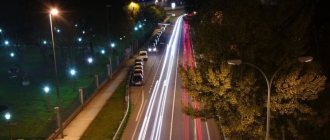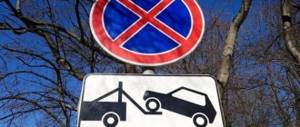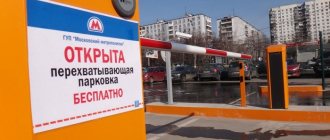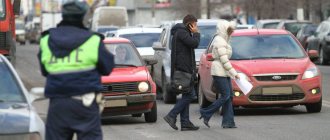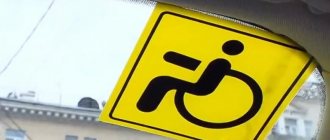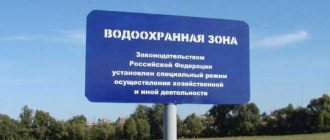Rules for stopping and parking
A pedestrian crossing is a part of a highway designated for pedestrians to safely cross the roadway. For additional convenience, the area is allocated. This is done using:
- Special markings on the road surface in the form of alternating stripes (zebras).
- Installation of road signs “Pedestrian crossing” in addition to markings.
The rules for stopping and parking vehicles are regulated by section 12 of the Traffic Rules. In accordance with it, stopping (stopping the movement of a vehicle for up to 5 minutes) and parking (stopping for more than 5 minutes) in the pedestrian crossing area is prohibited. It is allowed to stop a vehicle no closer than 5 meters before the marking. In its absence, the landmark indicating the boundaries of the pedestrian crossing zone is road signs.
When is it permissible to stop in a pedestrian crossing area?
In some cases, it is permitted to stop/leave a vehicle in a pedestrian crossing area:
- after crossing the markings (permissible when driving in your own lane);
- immediately before/five meters after a pedestrian crossing on the left side of the road (with two lanes), provided that the vehicle does not block the view of drivers and does not create an obstacle to the movement of pedestrians.
The rules allow a forced stop at a pedestrian crossing or in its immediate vicinity. In this case, the driver must turn off the emergency signal and try again to start the engine. In case of failure, it is necessary to move the car beyond the limits of the “Pedestrian Crossing” sign manually or with the assistance of third parties. Next, you need to act according to the situation: install an emergency stop sign and call repairmen or carry out repair work yourself.
The driver also has the right to stop driving due to poor health. Formally, in this situation, the traffic police officer cannot issue a fine, but at the same time he has the right to offer assistance and call an ambulance. If the offender refuses, the inspector may have doubts about the veracity of his actions and will be regarded as deception.
Fines for parking in the wrong place
The driver may be fined for violating parking rules. The size of the fine depends on the type of offense, the legal status of the offender, the region and some other parameters.
It should be remembered that if an offense is detected, the traffic police inspector must not only issue a fine, but also require the driver to repark his vehicle in any other place where parking is permitted. If the driver who committed the offense is not near the car, then the traffic police inspector has the right to evacuate the vehicle using a tow truck to the penalty area.
Tow truck services are paid, and they are paid by the driver of the vehicle. Also, the driver will have to pay for vehicle idle time at the impound lot for each day of idle time (if the idle time is more than 24 hours).
Thus, the total amount of damages for illegal parking consists not only of a fine, but also of the costs of evacuation and demurrage of the vehicle in the penalty area if the driver is not near the car during the preparation of the administrative violation report.
Parking at a public transport stop
The following penalties are imposed for parking at a public transport stop:
- For parking at a public transport stop, the vehicle driver will be fined 2,000 rubles. If the offense was committed in Moscow or St. Petersburg, the driver will be fined 3,000 rubles.
- It should be remembered that the driver of the vehicle has the right to stop to unload or put a passenger in the vehicle, if stopping the vehicle does not create interference for other road users. There are no penalties for this.
- If the driver of a vehicle stopped at a public transport stop in order to drop off or board a passenger in the vehicle, but stopping the vehicle created interference for other road users, then in this case the driver may be fined 1,000 rubles.
Parking on the sidewalk and pedestrian crossing
Parking on the sidewalk and pedestrian crossing is prohibited. The following penalties apply for violations of this rule:
- For parking on the sidewalk and pedestrian crossing, a fine of 1,000 rubles is imposed. If the offense was committed in Moscow or St. Petersburg, the fine will be 3,000 rubles.
- A fine is not imposed on a driver on the sidewalk or pedestrian crossing in case of forced parking if the driver took all measures and removed the vehicle after the circumstances that led to the forced stop of the vehicle on the sidewalk or pedestrian crossing disappeared.
- You should also remember that not only parking is prohibited, but also driving on pedestrian paths and sidewalks. For ignoring this rule, the driver will be fined 2,000 rubles.
This is interesting: Alternating current generator: device, principle of operation, technical characteristics and 7 types of devices
Parking in disabled spaces
Only those people who can confirm their status with documents have the right to park in spaces for disabled people. Otherwise, the driver may be fined:
- For parking in spaces for disabled people, a person will be fined 5,000 rubles.
- A disabled driver must have a document with him that confirms his disability. The traffic police inspector has the right to demand the presentation of this document to make sure that the person really is disabled. If the driver is disabled, but does not have a document confirming his disability, then in this case the driver will be fined according to the general rules.
- It is not at all necessary for a disabled person to put up a special warning sign “Disabled”, since this requirement is not recorded in the traffic rules.
Parking on the lawn
Regarding parking on the lawn, the following is known:
- Parking on the lawn is an administrative offense that is regulated not by uniform traffic rules, but by special regional laws. Therefore, the size of the fine depends very much on the region where the offense was committed.
- Consider this example: you live in Moscow and parked on the lawn - in this case, the parking fine will be 5,000 rubles. But such a fine will be imposed if you are an individual. If the violator is an official, then the fine will be 30,000 rubles, and if the violator is a legal entity - 300,000 rubles.
- Also in Moscow there are other rules regarding parking on the lawn, for violation of which the driver may be additionally fined. For example, if parking on a lawn resulted in damage to green spaces, the driver may be fined either 3,500 - 4,000 rubles (if the driver is an individual), or 50,000 rubles (if the driver is an official), or 300,000 rubles (if the driver is an legal entity).
- In other cities of Russia, the size of fines may be different. For example, in Ryazan the fine for parking on the lawn is either 500 - 2,000 rubles (for individuals), or 1,000 - 5,000 (for officials), or 5,000 - 20,000 rubles (for legal entities).
Second row parking
Traffic rules oblige vehicle drivers to park their cars in one row. The following penalties are provided for violating this rule:
- For parking in the second row (except for two-wheeled vehicles without a trailer), the driver will be fined 1,500 rubles. If the offense was committed in St. Petersburg or Moscow, the driver will be fined 3,000 rubles.
- Two-wheelers without a trailer are allowed to park in two rows. If a trailer is attached to a two-wheeled vehicle, then it is prohibited to park such a vehicle in the second row, and for ignoring this rule the driver will be fined according to the general rules.
Parking within the coverage area of special signs or markings
There are special signs and markings that prohibit drivers from parking on certain sections of the road. For violating this rule, the driver may be fined:
- If you ignored prohibiting signs and markings and parked within their coverage area, you will be fined 500 rubles. If the offense was committed in St. Petersburg or Moscow, the driver will be fined 1,500 rubles.
- The main prohibitory signs are the signs “Parking is prohibited”, “Parking on even days is prohibited” and some others. The effect of each sign extends only to the side of the road on which it is installed. There is also a special road marking in the form of a zigzag white line, which prohibits parking on a certain section of the road.
Parking in the yard
The driver has the right to park his car in the yard subject to the following rules:
- The vehicle does not create insurmountable barriers for pedestrians.
- The vehicle does not block passages to houses and entrances.
- It is prohibited to park on the territory of schools, playgrounds or sports grounds, kindergartens, and so on.
- Vehicles with a maximum weight of more than 3.5 tons should be parked in special areas. If these areas are not available, then parking such vehicles in the yard is prohibited.
- Parking of vehicles with the engine running actively for more than 5 minutes is prohibited (except when loading or unloading passengers or cargo).
- For ignoring the above rules, the driver will be fined 1,500 rubles. If the offense was committed in St. Petersburg or Moscow, the fine will be 3,000 rubles.
- The driver may also be fined for violating other traffic rules. For example, parking on the lawn in the yard is also an offense, and the amount of the fine is determined according to the general rules.
Parking near ponds
The rules for parking near reservoirs are as follows:
- It is allowed to park vehicles near bodies of water on roads and special areas with hard surfaces. It is also allowed to park a vehicle outside water protection zones (the size of the water protection zone for reservoirs is 50 meters). In other cases, parking a vehicle near bodies of water is prohibited.
- For ignoring this rule, the driver will be fined either 3,000 - 4,500 rubles (individual), or 8,000 - 12,000 rubles (official), or 200,000 - 400,000 rubles (legal entity).
This is interesting: Self-replacement of the coolant temperature sensor: 2 types and 7 signs of their malfunction
Fine for unpaid parking
Regarding the fine for unpaid parking, the following is known:
- Unpaid parking of a vehicle in paid parking areas is an administrative offense that is regulated not by uniform traffic rules, but by special regional laws. Therefore, the size of the fine depends very much on the region where the offense was committed.
- For example, in Moscow or St. Petersburg a person will have to pay 2,500 rubles, while in Ryazan the fine for illegal parking will be 1,500 rubles.
Fine for stopping at a pedestrian crossing
If a driver, neglecting traffic rules, stops a vehicle at a pedestrian crossing marking, he may be held administratively liable. In this case, Article 12.19 of the Code of Administrative Offenses
.
It provides for punishment in the form of a fine in the amount of 1000 rubles
.
If the violation occurred in a city of federal significance (Moscow, St. Petersburg), the amount of the administrative fine increases to 3,000 rubles
.
Also, the traffic police inspector has the authority to issue a report on the detention of the vehicle with its subsequent evacuation from the scene of the incident. This is done in the case when the driver is not present at the time the violation is recorded.
The very fact of moving the car to the impound lot increases the driver's costs. He is financially responsible for transportation by a tow truck and maintaining the car at the impound site. He undertakes to compensate all costs in accordance with current tariffs. Payment is required. It can be paid after receiving the car along with the amount of the fine.
Fine for parking at a pedestrian crossing for legal entities
Part 1 art. 2.10. The Code indicates that legal entities are subject to liability in the cases specified in the Special Part of the Code.
Part 2 art. 2.10. states that the provisions of the Law apply equally to both individuals and legal entities, with the exception of cases where, within the meaning of any norm, it can be applied only to an individual.
In Part 7 of the official commentary to Art. 12.19. The Code establishes that drivers of vehicles are recognized as subjects of the violation in question. According to the meaning of the norm, the violation is committed by the driver, and not by the legal entity that owns the vehicle.
Based on the above, legal entities and officials are held liable under Part 3 of Art. 12.19. are not involved.
How to appeal a penalty
The driver has the right to appeal the imposition of a fine in a number of cases:
- facts confirming the unlawful action of traffic inspectors;
- errors and inaccuracies in the protocol that contradict the real situation;
- documentary data confirming the driver’s absence of guilt (photos, videos, witness statements).
The complaint must be drawn up and filed within 10 days after drawing up the incident report. It is sent to the head of the regional traffic police department or to the court at the place of residence (registration). If a citizen missed this deadline, he also has the right to file a petition to restore the deadline for filing an appeal. In controversial situations, professional legal support may be required.
